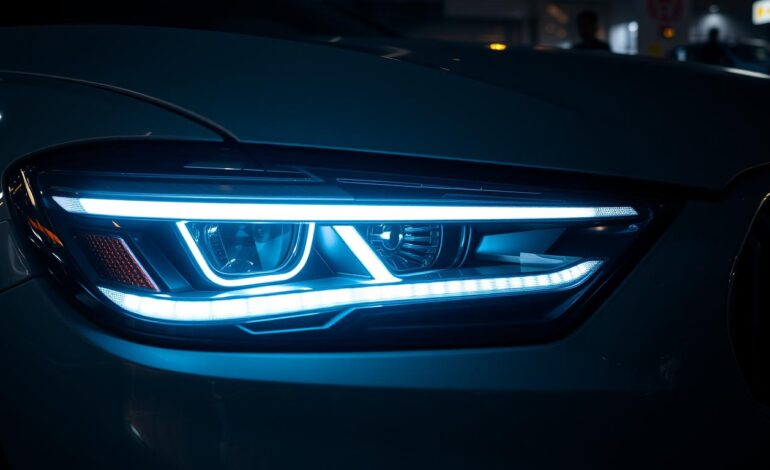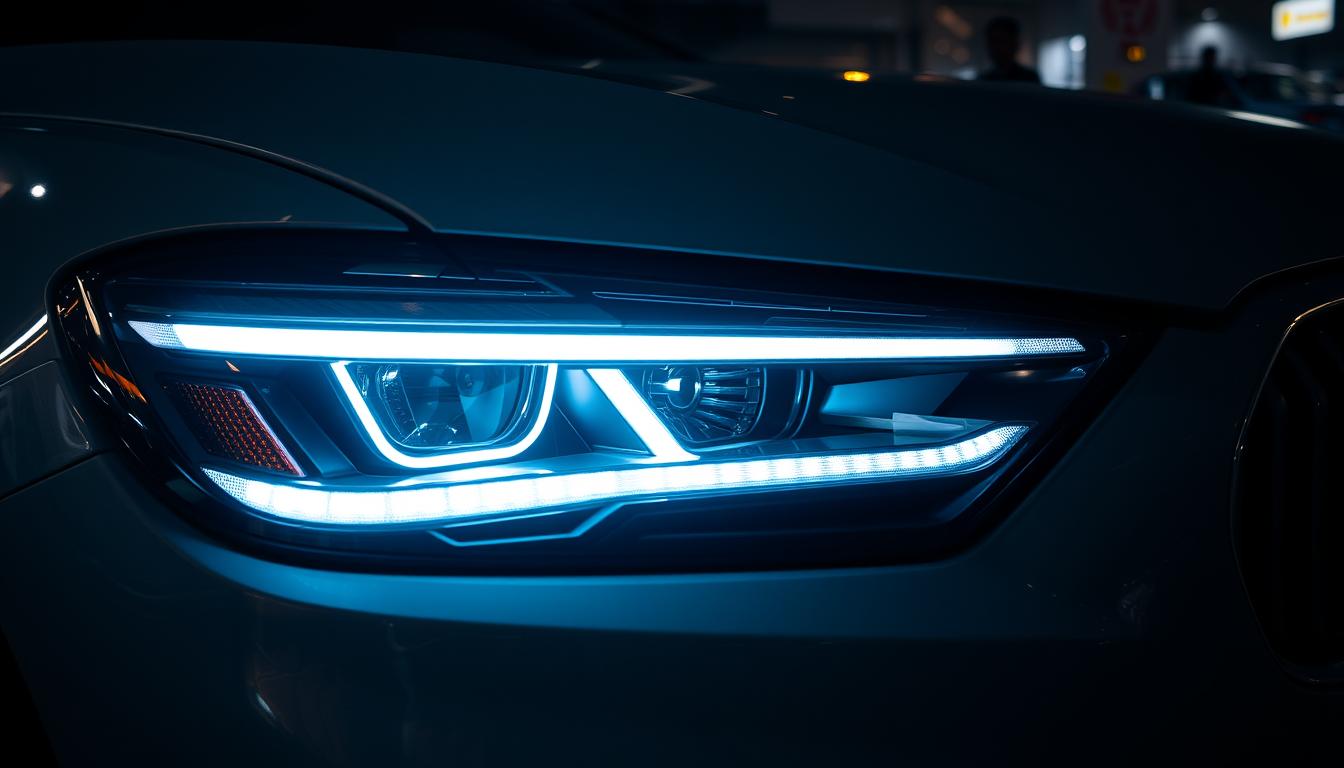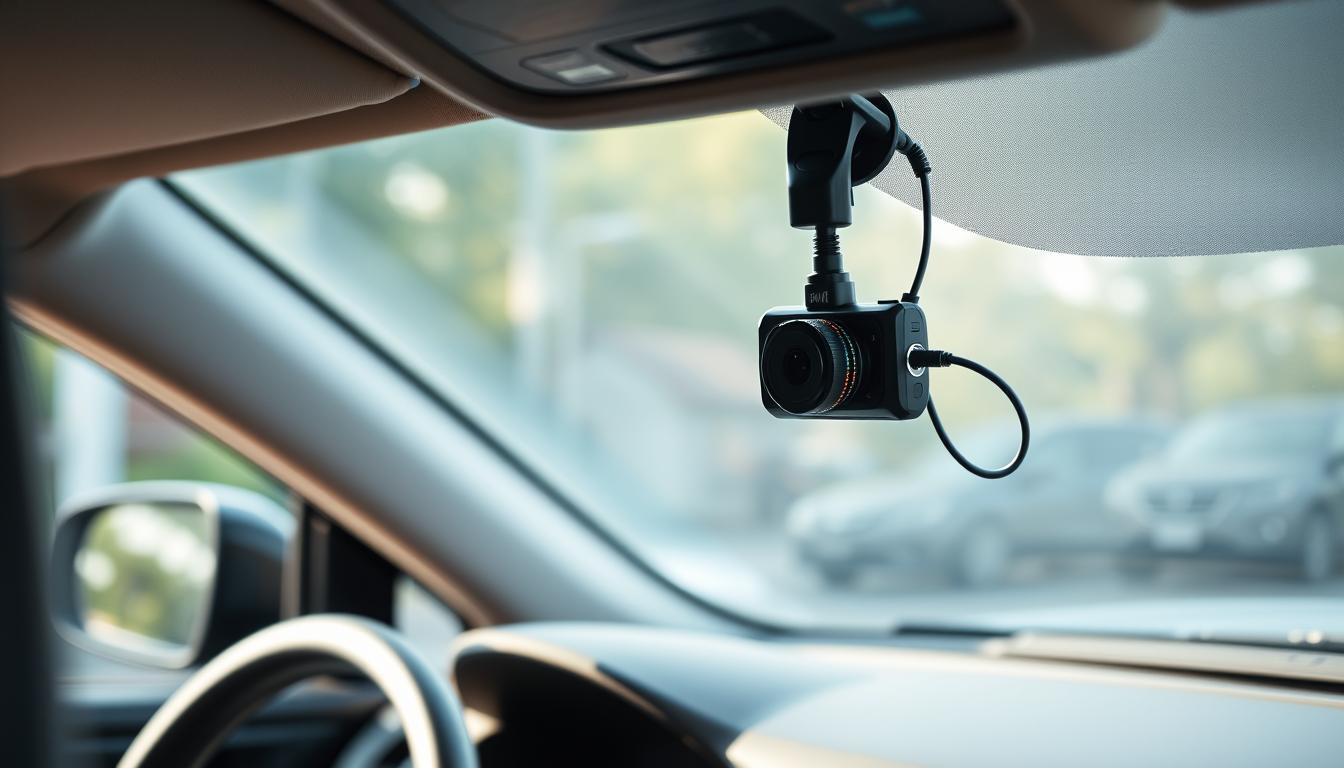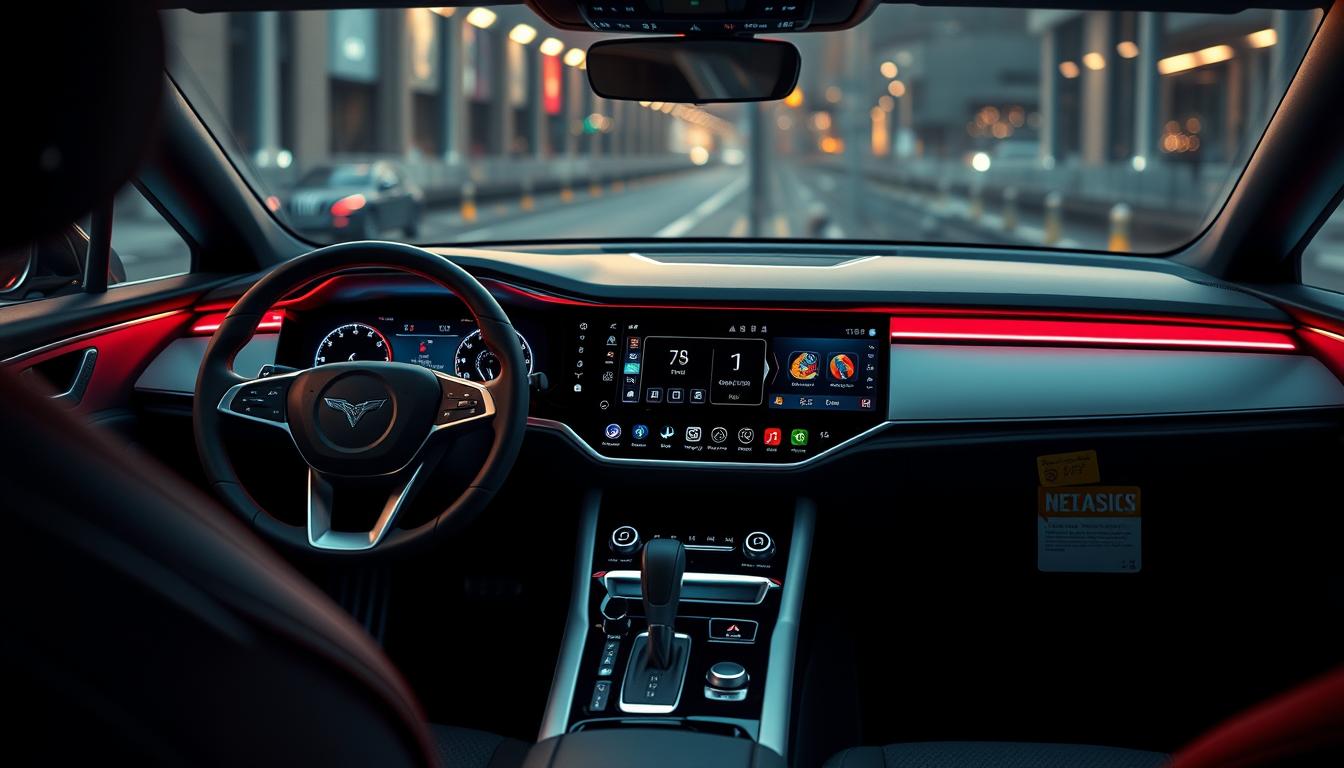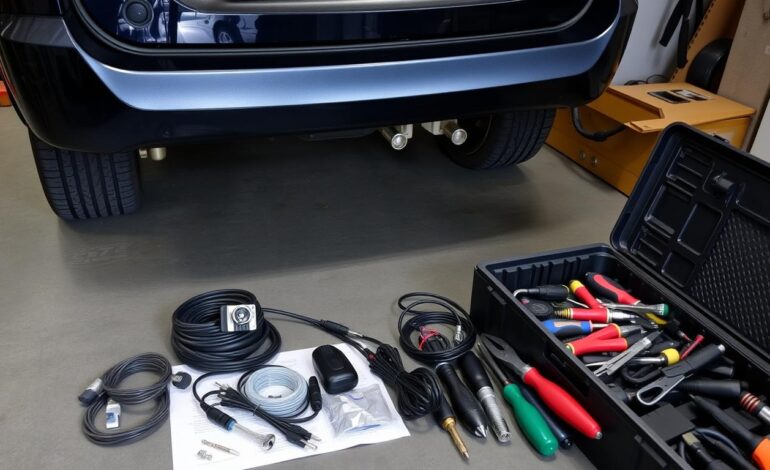
DIY Guide to Adding a Backup Camera
A backup camera is vital for car safety, and this DIY guide makes it easy to add one to your vehicle. You’ll need to pick the right backup camera DIY kit and follow a detailed installation guide. This will boost your car’s safety and give you a clear view when reversing.
Installing a backup camera is straightforward, requiring only basic tools and materials. It’s critical to understand the role of car safety and how a backup camera can prevent accidents. With the growing popularity of backup camera DIY kits, finding the right one for your vehicle is now easier.
This guide will help you install a backup camera, improving your car’s safety. It covers choosing the right spot, wiring, and testing the camera. Whether you’re an experienced DIYer or new to it, this guide offers all the info you need for a successful installation.
Key Takeaways
- Installing a backup camera is a simple DIY process that can enhance car safety.
- Choosing the right backup camera DIY kit is essential for a successful installation.
- A backup camera provides a clear view of the surroundings while reversing.
- The installation process involves basic tools and materials.
- Consider the importance of car safety when installing a backup camera.
- A backup camera can help prevent accidents and enhance overall car safety.
- Follow a step-by-step guide to ensure a successful installation.
Understanding Backup Camera Systems
Enhancing car safety is key, and a rearview camera is vital. Before you install one, knowing the various systems is essential. This knowledge aids in making a well-informed choice, ensuring you pick the right fit for your vehicle.
A typical backup camera system includes a camera, a monitor, and wiring. The camera captures what’s behind your car, and the monitor shows the image. This setup boosts visibility, lowers accident risks, and improves car safety.
- Improved visibility, even in dim light
- Lowered risk of hitting pedestrians or objects
- Boosted car safety with alerts and warnings
Understanding the different backup camera systems and their parts is key. It helps you make a smart choice for your vehicle. This choice enhances car safety and minimizes accident risks, making driving safer and more enjoyable.
Essential Tools and Materials for Installation
To start your backup camera DIY project, having the right tools and materials is key. You’ll need a drill, screwdrivers, and wiring connectors. Understanding electrical systems and wiring is also vital.
For a backup camera DIY installation, the correct tools are essential. Here are the main items you’ll need:
- Drill and bits
- Screwdrivers (both flathead and Phillips)
- Wiring connectors
- Electrical tape
- Wire strippers
The tools and materials needed can vary based on your backup camera and vehicle type. Always check your vehicle’s manual and the manufacturer’s instructions for specific guidance.
With these essential tools and materials, you’re set for a successful backup camera DIY installation. Take your time and work carefully for a safe and proper installation.
With the right tools and patience, you can enjoy the safety and convenience of a backup camera system.
Safety Precautions Before Starting Your Backup Camera Installation
Installing a backup camera DIY can significantly improve your car’s safety features. Yet, it’s vital to take safety measures before starting. This is to prevent accidents or injuries during the process.
To create a safe workspace, start by preparing your vehicle. Turn off the engine, engage the parking brake, and shift into park. Also, ensure the area around your car is free from obstacles or tripping hazards.
Vehicle Preparation Steps
- Turn off the engine and engage the parking brake
- Put the vehicle in park
- Clear the area around the vehicle of any obstacles or tripping hazards
Electrical safety is critical in backup camera DIY installations. Always disconnect the battery and avoid short circuits. These steps will help ensure a safe and effective installation.
Electrical Safety Guidelines
Always prioritize car safety when dealing with electrical systems. If unsure about any part of the installation, seek professional advice. This is to avoid any risks.
Choosing the Right Location for Your Backup Camera
Installing a rearview camera is all about car safety. To ensure optimal visibility and safety, picking the right location for your backup camera is essential. The camera’s angle and position greatly impact the clarity of the view around it.
Proper installation is vital for the effectiveness of your rearview camera. When choosing a location, consider these factors:
- Obstruction-free view: Opt for a spot that offers a clear view of the area behind your vehicle.
- Weather resistance: Pick a location that shields the camera from harsh weather, like direct sunlight, rain, or snow.
- Angle adjustment: Make sure the camera can be adjusted to show a clear view, including any blind spots.
A well-installed rearview camera greatly improves car safety. It reduces the risk of accidents and injuries. By considering these points and choosing wisely, you ensure your backup camera offers a clear and reliable view.
Always check your vehicle’s manual or the manufacturer’s guidelines for specific installation advice. With the correct location and installation, you’ll enjoy better car safety and peace of mind while driving.
Wiring and Power Connection Guide
Installing a backup camera DIY is all about car safety. The wiring and power connection are key. A good connection is vital for your system to work right and show what’s behind your vehicle clearly.
First, pick the best power source for your backup camera. You can link it to your vehicle’s reverse lights. This turns the camera on when you go into reverse. Or, you can use a constant power source like the battery or an accessory outlet.
Power Source Options
- Reverse lights: This is the most common power source, as it allows the camera to activate automatically when you shift into reverse.
- Constant power source: This option provides power to the camera at all times, but may require additional wiring and circuitry.
After choosing your power source, you’ll need to run the wires to the camera and monitor. This can be tough, mainly if you’re new to your vehicle’s electrical system. Make sure to use wire routing that doesn’t harm your vehicle’s interior or exterior.
Connection Testing Methods
To check if your backup camera system works, test the connection. First, turn on the power source and see if the camera turns on. Then, check the video on the monitor. It should be clear and without any interference.
Monitor Installation and Setup Process
Installing a rearview camera boosts your vehicle’s safety features. With a DIY project, you can save money and gain a new skill. The monitor installation and setup process requires attention to detail for a smooth experience.
First, pick a spot for your monitor that offers a clear view of the camera’s feed. This is often on the dashboard or center console. After choosing a location, start the installation. This might involve drilling holes for the mounting hardware or wiring the monitor to the vehicle’s electrical system.
Some important tips for monitor installation include:
- Ensure the monitor is securely mounted to prevent movement while driving
- Route wires carefully to avoid damage or interference with other systems
- Adjust display settings for optimal image quality and a clear view of the camera’s feed
A DIY rearview camera project can be both fun and rewarding. With the right tools and knowledge, you can create a safe and reliable system. By following these tips and taking your time, you can enhance your vehicle’s safety features.
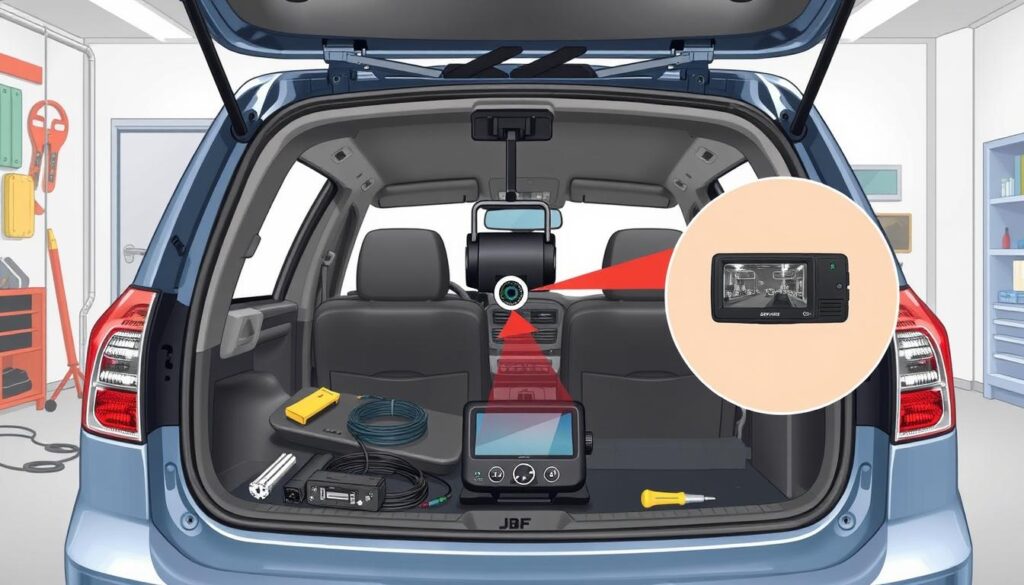
After installation, thoroughly test your rearview camera system. This ensures it’s working correctly and providing a clear view of the area behind your vehicle. With patience and practice, you’ll enjoy the peace of mind that comes with a reliable rearview camera system.
Camera Mounting and Alignment Tips
Proper camera mounting and alignment are key for optimal visibility and car safety. When tackling a backup camera DIY installation, accuracy is vital to prevent risks. Follow these guidelines for mounting and aligning your backup camera for the best results.
Start by selecting a spot that offers a clear view of what’s behind your vehicle. This is critical for car safety and ensures you can spot obstacles or people when reversing. The camera’s height should allow for an unobstructed view, considering any blind spots.
Adjusting the camera’s angle is also critical. It should capture the area directly behind your vehicle and any possible hazards. This is more challenging with backup camera DIY setups, where getting the angle wrong is easy if you’re not precise.
Optimal Mounting Positions
- Choose a location that provides a clear view of the area behind your vehicle
- Consider the height and angle of the camera to ensure optimal visibility
- Take into account any possible blind spots or obstacles
By adhering to these tips and guidelines, you can ensure your backup camera DIY installation is correct and enhances car safety. Remember, mounting and aligning your camera requires patience and attention to detail. It’s a critical step in the installation process.
System Testing and Calibration
To ensure your rearview camera system is functioning correctly, it’s essential to test and calibrate it. This involves verifying the image quality, setting up distance markers, and testing the night vision capabilities. By doing so, you can guarantee optimal performance and enhance car safety.
When testing the system, start by checking the image quality. Ensure the video feed is clear and free of distortions. Park your vehicle in a well-lit area and observe the display. If the image appears blurry or distorted, adjust the camera’s position or clean the lens.
Image Quality Verification
Verifying the image quality is essential for a reliable rearview camera system. Use the following steps to verify the image quality:
- Check the video feed for any distortions or blurriness
- Adjust the camera’s position or clean the lens if necessary
- Test the system in different lighting conditions
Also, test the night vision capabilities of your rearview camera system. Park your vehicle in a dark area and observe the display. If the image appears too bright or too dark, adjust the camera’s settings.
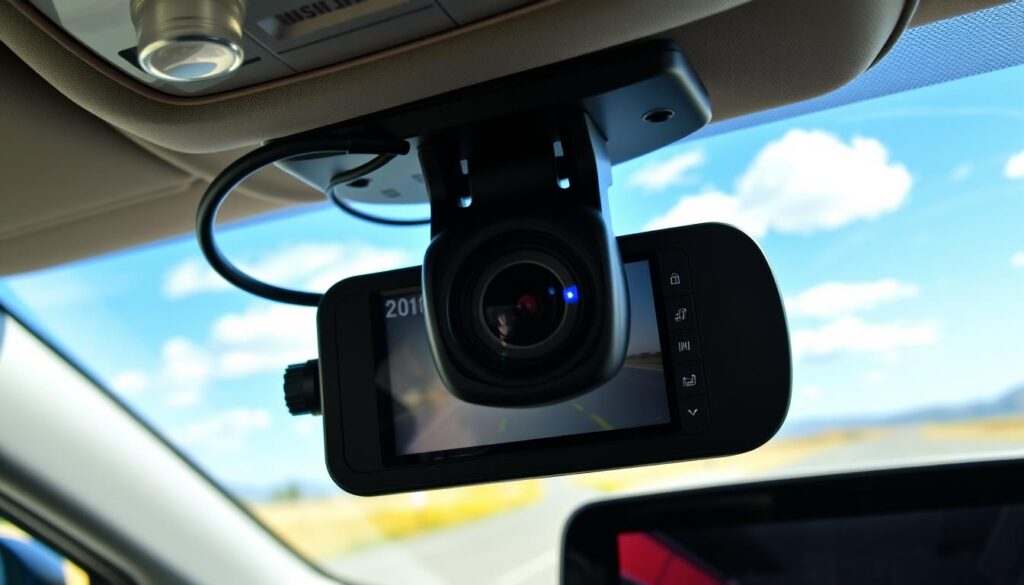
Distance Marker Setup
Setting up distance markers is another important aspect of calibrating your rearview camera system. Adjust the guidelines on the display to match the actual distance between your vehicle and any obstacles. This ensures accurate distance measurements and enhances car safety.
Common Installation Challenges and Solutions
Embarking on a backup camera DIY project emphasizes car safety above all. You might face common issues like poor image quality, faulty wiring, and incorrect camera mounting during installation. These problems can be both frustrating and time-consuming to solve.
To navigate these hurdles, having a reliable troubleshooting guide and expert advice is critical. Below are some typical installation challenges and their solutions:
- Poor image quality: Inspect the camera’s lens for dirt or debris and clean it if necessary. Also, ensure that the camera is properly connected to the monitor and that the monitor is set to the correct input.
- Faulty wiring: Inspect the wiring for any signs of damage or wear and tear. Replace any damaged wires and ensure that all connections are secure.
- Incorrect camera mounting: Check the camera’s mounting position and adjust it if necessary. Ensure that the camera is level and pointing in the correct direction.
By adhering to these troubleshooting tips, you can overcome common installation challenges. This ensures your backup camera system operates correctly. Always prioritize safety when working with electrical systems. If unsure about any part of the installation, consider consulting a professional.
With dedication and perseverance, you can successfully install a backup camera system. This will enhance your car’s safety. A well-installed backup camera system offers a clear view of the area behind your vehicle. It helps prevent accidents and ensures a safer driving experience.
Conclusion: Enjoying Your New Backup Camera System
After installing your rearview camera, you’re set to enjoy its numerous advantages. This system boosts your visibility and safety while reversing or navigating tight spaces. It’s important to keep the camera and monitor in good condition. This ensures they work well and provide clear images.
Should you face any problems with your DIY backup camera setup, this guide’s troubleshooting tips can help. With some basic knowledge, you can quickly solve common issues. This way, your system will always be in top shape. Embrace this technology and drive with confidence, knowing you have a valuable tool at your disposal.


